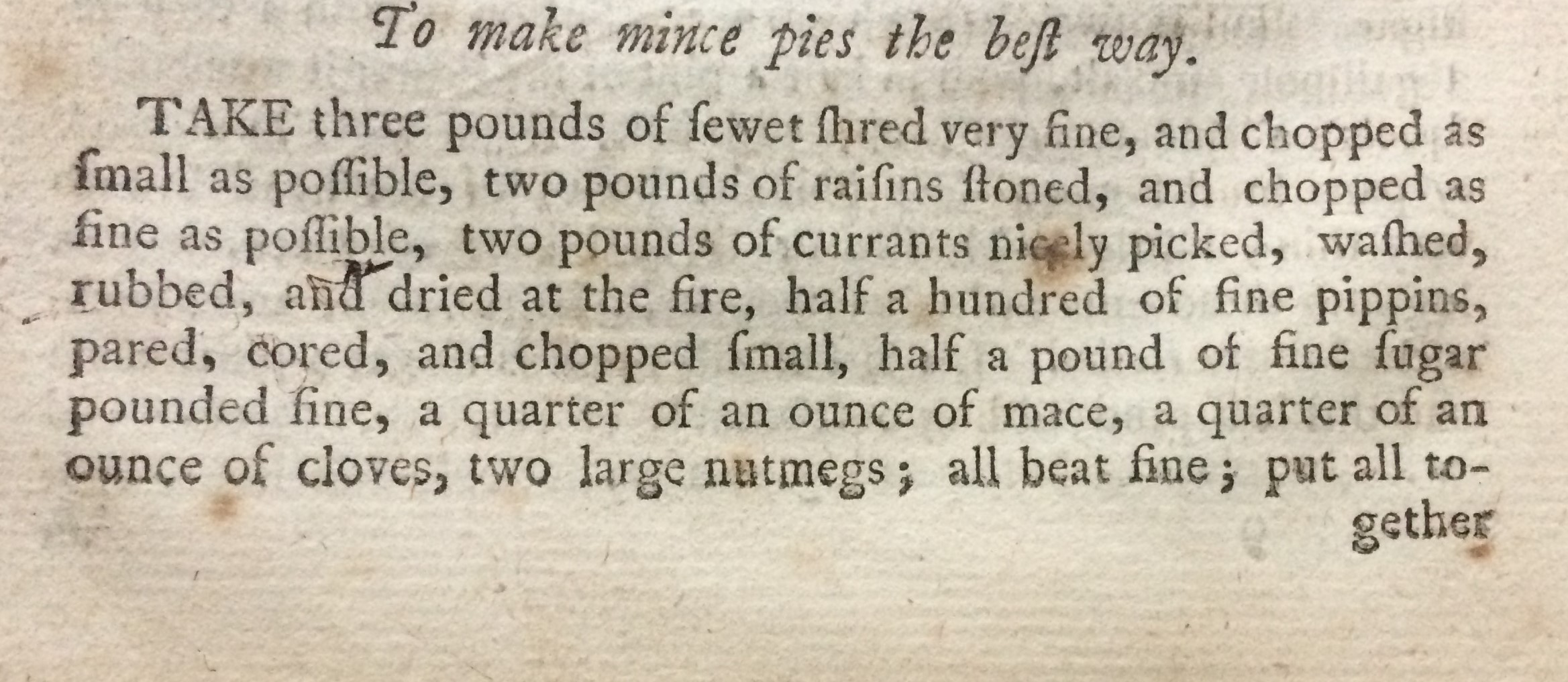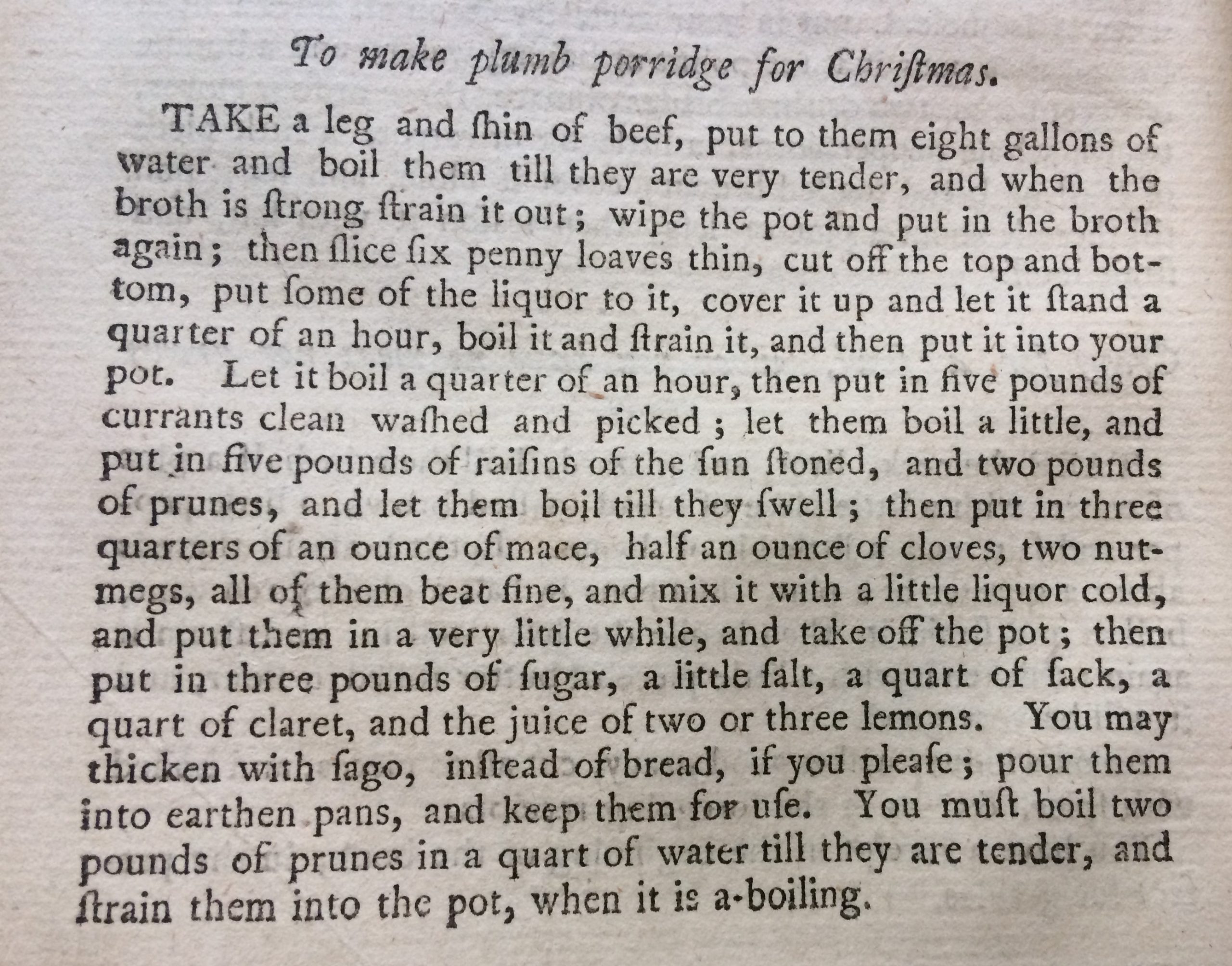Posted:
11 Dec 2020
Food is an important part of Christmas festivities and many of our present day gastronomic traditions have their origins in centuries old recipes. These recipes were shared by word-of-mouth or passed down in private notes or journals, but from the 17th century the first printed cook books began to appear. These provide a fascinating insight into past traditions and how culinary tastes have changed over time. At Trinity Hall we have two cook books in our collection, which were both best-sellers that revolutionised cooking in the 17th and 18th centuries. This post will look at some of the festive treats contained within them.
The French Cook
One of the most important cook books of the 17th century was The French Cook, first published in Paris in 1651 [1]. It was written by François Pierre de la Varenne (c1615–1678) — chef to the Marquis d’Uxelles, so as such, he was tasked with producing food to impress the crème de la crème of French society.
La Varenne’s cook book was intended for a professional audience rather than home cooks — as he says in his preface it was written for: “my fellows in the profession… of whom some, lacking experience or a ready memory, are unwilling or too timid to become involved in learning what they do not know…”The French Cook was a best-seller and enormously influential across Europe. In 1652, a year after its first publication, it became the first French cook book to be translated into English by “IDG”. [2] It was to influence cookery across Europe, leading to a move away from highly spiced sweet and sour dishes towards a more natural savoury cuisine.
The recipes in La Varenne’s book do not contain any detailed instructions or helpful measurements for the cook. The modern reader would find many of the dishes suitable for a food trial on the television show I’m a Celebrity, in particular cow udder, pottage of tortoise, head of wild boar, and ‘calfes feet fried’.
Of the more palatable recipes is the familiar festive favourite — turkey, which was a popular meat for Christmas in France as early as the 16th century. The French Cook contains a basic recipe for roast turkey: “It must likewise be plumed dry, whiten it on the fire, rost it, and serve.” For the more adventurous chef there is also a more avant garde recipe for turkey with raspberries, which you could imagine in the cookery books of celebrity chefs today:
Turkie with Raspis
When it is dressed, take up the brisket, and take out the flesh, which you shall mince with suet and some little of Veal-flesh, which you shall mix together with yolks of Eggs & young Pigeons, & all being well seasoned, you shall fill your Turkie with it, and shall season it with Salt, Peper, beaten Cloves and Capers, then you shall spit it, and turn it very softly; When it is almost rosted, take it up, and put it into an Earthen pan with good Broath, Mushrums, and a bundle of Herbs, which you shall make with Parsley, thime, and Chibols tied together; for to thicken the sauce, take a little Lard sliced, pass it in the pan, and when it is melted, take it out, and mix a little flower with it, which you shall make very brown, and shall allay it with a little Broath and some Vinegar; then put it into your Earthen pan with some Lemon-juice, and serve.
If it be in the Raspis season, you shall put a handfull of them over it, if not, some Pomgranate.
The Art of Cookery Made Plain and Easy
At the start of the 18th century the French courtly way of cooking still predominated in refined households. Cook books were usually written by male chefs who offered complicated recipes, designed for professional cooks and without any detailed or practical instructions.
In Georgian England the aspiring home cook’s prayers would be answered by the Delia Smith of the day, with the publication of The Art of Cookery Made Plain and Easy by ‘A lady’ [3]. This cook book, first published in 1747, was in fact, written by Hannah Glasse (1708–1770). When her husband got into financial difficulties, she wrote the book as a means of raising money to support the family. The recipes were extensively ‘borrowed’ from earlier books by other writers.
Glasse’s book became the most popular cook book of its time going through twenty editions in the 18th century. A key reason for its popularity was that it was intended for the everyday cook and so it contained simple, detailed instructions on how to make dishes. In the introduction she states: “I believe I have attempted a Branch of Cookery which Nobody has yet thought worth their while to write upon”. Glasse was a severe critic of the French influence of British cuisine, although she does include simpler versions of French recipes in her cook book.
The Art of Cookery Made Plain and Easy contains several recipes for Christmas favourites including mince pies. Although unlike the modern version, they include meat (usually mutton, beef or pork) as an ingredient. Glasse’s recipe contains neat’s (beef) tongue, sirloin of beef and three pounds of suet; along with sugar, the spice mace, cloves, and nutmeg, currants, raisins, apples, brandy, red wine and lemon juice.

Recipe to make mince pies the best way
These were used to produce a single large pie, which must have been substantial enough to serve many people at once. The idea of sweet, spiced minced beef sounds quite unpalatable to modern tastes, but it was not until the late Victorian period that mince pies became meat-free. It appears that they weren’t just eaten at Christmas either — there is also a recipe for Lent mince pies (chopped eggs replaces the meat).
If this hasn’t whetted your appetite, consider her recipe for ‘Plumb porridge for Christmas’. This delicious gem contains a whole leg and shin of beef, which was boiled into a stock, thickened with bread, spiced, and mixed with dried currants and raisins, plums, sugar and wine. The quantities of meat and dried fruit are enormous!

Recipe to make plumb porridge for Christmas
Although families were generally much larger in Georgian times, it is evident that this recipe would have produced a vast quantity of porridge that would last for weeks. It could be prepared ahead of Christmas, and then perhaps heated up in smaller amounts to give to guests during social visits.
By the end of the 18th century the tradition of eating plum porridge had vanished. If you are inspired to make this dish yourself or are wondering whether it tasted as revolting as it sounds, you can read about Allegra McEvedy’s attempt to recreate it using a recipe from Martha Bradley’s 1756 cook book The British Housewife, or the Cook’s, Housekeeper’s and Gardiner’s Companion. [4]
Inscriptions inside the book show that our copy had two women former owners: Sarah Ann Parsons who owned it in 1841 and Mrs S. Wal[she?], 1850. It is in rather poor condition, and there is some staining to indicate that it was used for cooking. Although strangely not on the pages of these festive recipes. Personally, I will be sticking with my usual nut roast this year.
References
[1] La Varenne, François Pierre De, Le Cuisinier François Paris, 1651.
[2] La Varenne, François Pierre De, The French cook: Prescribing the way of making ready of all sorts of meats, fish and flesh, with the proper sauces, either to procure appetite, or to advance the power of digestion. Also the preparation of all herbs and fruits, so as their naturall crudities are by art opposed; with the whole skil of pastry-work. Together with a treatise of conserves, both dry and liquid, a la mode de France. With an alphabeticall table explaining the hard words, and other usefull tables. / Written in French by Monsieur De La Varenne, clerk of the kitchin to the Lord Marquesse of Uxelles, and now Englished by I.D.G. London: Printed for Charls Adams, and Are to Be Sold at His Shop, at the Sign of the Talbot Neere St. Dunstans Church in Fleetstreet, 1653. Trinity Hall Strangman Collection 641.59 VAR. Available online at http://name.umdl.umich.edu/A88798.0001.001
[3] Glasse, Hannah, The Art of Cookery, Made Plain and Easy. The eighth ed., Printed for A. Millar, J. and R. Tonson, W. Strahan, T. Caslon, B. Law, and A. Hamilton, 1763. Available online at: https://wellcomelibrary.org/item/b28757075
[4] McEvedy, Allegra and Martha Bradley, ‘How about Christmas ‘plumb porridge’?’ The Guardian Tue 15 Dec 2009. Accessed 11/12/20 at: https://www.theguardian.com/lifeandstyle/wordofmouth/2009/dec/15/christmas-plum-porridge-recipe